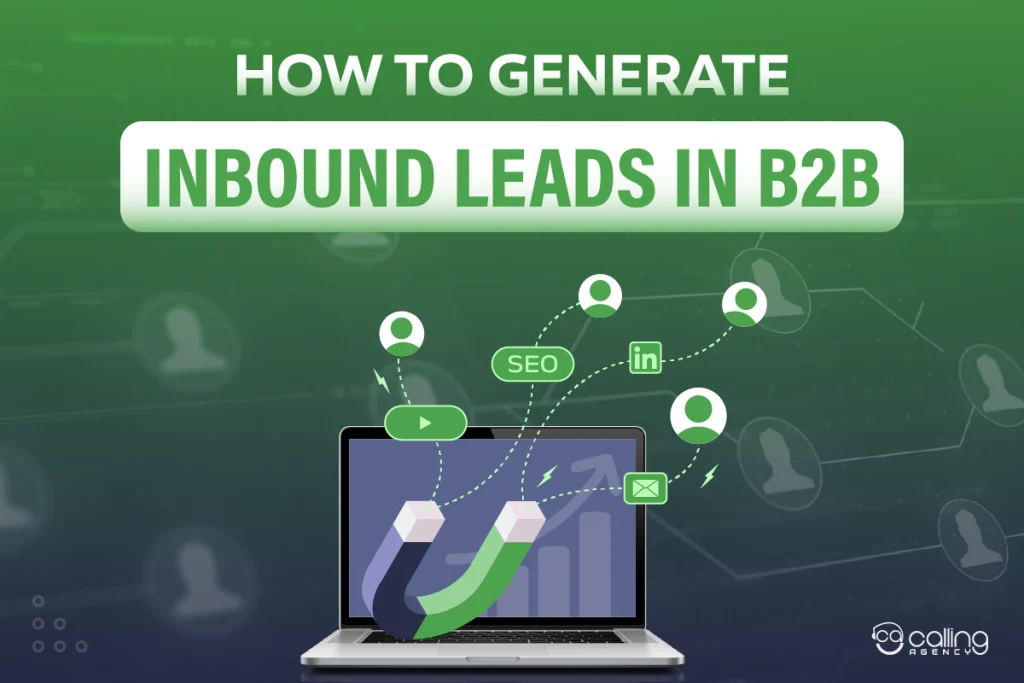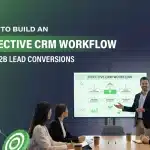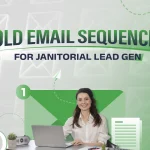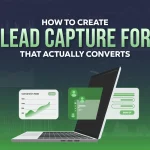It is a dream scenario when there will be a constant supply of inbound leads. They do not have to contact leads and come to you already interested. The point is, is your attraction intentional?
One of the primary objectives of a B2B business is to produce inbound leads. Inbound marketing involves the art of drawing visitors to your site in order to develop them into leads, grow your customer base and generate a handsome ROI.
It is important to remember that interest is not intent. In the case of B2B inbound lead generation, you prefer to draw in an intent lead. We are here to demonstrate to you the most appropriate tools, strategies, and methods and their ways of use.
Let’s crack the code to generate inbound leads for B2B sales in this blog.
What Is B2B Inbound Lead Generation?
Critical B2B lead generation can be broken down into two types: inbound leads and outbound leads. While both strategies have their own function in marketing strategy, the last thing you would ever do is spend an eternity of time and thousands of dollars on lead-generation techniques that never result in loyal customers.
Inbound leads mean guaranteed conversion. Isn’t it?
Someone made an enquiry to your website. That is your inbound lead. It means your business is attracting leads on its own. Inbound leads also mean faster deal cycles and a better win rate.
Inbound lead generation is about creating compelling content that intrigues your prospects to initiate contact with you. Any activity that your prospects do on your website that helps you to get their contact information is considered inbound lead generation. You can collect information from content downloads, email opt-ins, sign-ups, free trials, or call schedules, and so on.
There are three main types of inbound leads:
- Marketing qualified leads (MQLs): These customers visited your website or social media profile to sign up for a guide, promotion, or other resource.
- Product qualified leads (PQLs): These customers have tried your product or services using a free trial or freemium version.
- Sales qualified leads (SQLs): These customers have reached out to your sales team about pricing or product information.
Hence, you need a proper lead strategy before you proceed with anything in inbound marketing. However, the difficulty level of inbound lead generation is comparatively higher than any other medium of lead generation.
Here are the main areas where inbound lead generation for B2B marketing can create challenges.
- Longer Sales Cycles
- Inbound Leads Are an Advanced Audience
- Run Out of Budget
Here’s how to qualify inbound leads:
- Develop your ideal customer profile (ICP).
- Gather lead demographics and other details.
- Score leads according to information such as company size, industry, budget, need, and other criteria.
- Segment and prioritize leads based on those most likely to buy.
- Reach out and engage with prospects to further qualify and convert.
Generating inbound leads means juggling a lot of information. There’s website traffic data, contact lists, CRM reports, SEO insights, and content analytics, all coming in from different directions. When that data isn’t properly cleaned or organized, even the most carefully built lead generation plan can start to fall apart. Keeping everything structured and easy to understand isn’t just a nice-to-have; it’s what makes the difference between a strategy that works and one that doesn’t.
Why Inbound Leads Matter in B2B?
Inbound leads are generated by individuals who have already expressed interest in your products or services by using multiple channels. These platforms include official websites, active social media presence and targeted marketing campaigns.
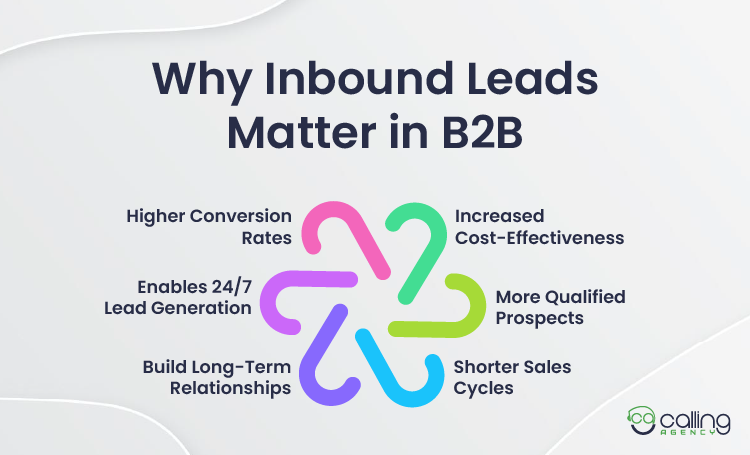
For instance, in-depth blogs explaining the current industry trends keep you informed but also solidify your reputation as a thought leader in the field. Additionally, interactive online webinars provide a platform for live interaction. It allows the attendees to ask questions and learn directly from the industry experts.
As they look for information, they get to know your brand and what you offer which makes it easier to sell to them. This interest helps to build trust and allows for more genuine conversations with potential customers.
Importance of Inbound Leads
- Higher Conversion Rates
- Increased Cost-Effectiveness
- More Qualified Prospects
- Shorter Sales Cycles
- Build Long-Term Relationships
- Enables 24/7 Lead Generation
Proven Strategies to Generate Inbound B2B Leads
In the current market situation, it is not enough to solely depend on word of mouth, trade shows, and recommendations in order to have a steady stream of sales. It has been found through research that 70% of the purchasers seek information on the Internet. They are visiting websites, engaging with social media, and reading customer-written reviews prior to making contact with a sales representatives.
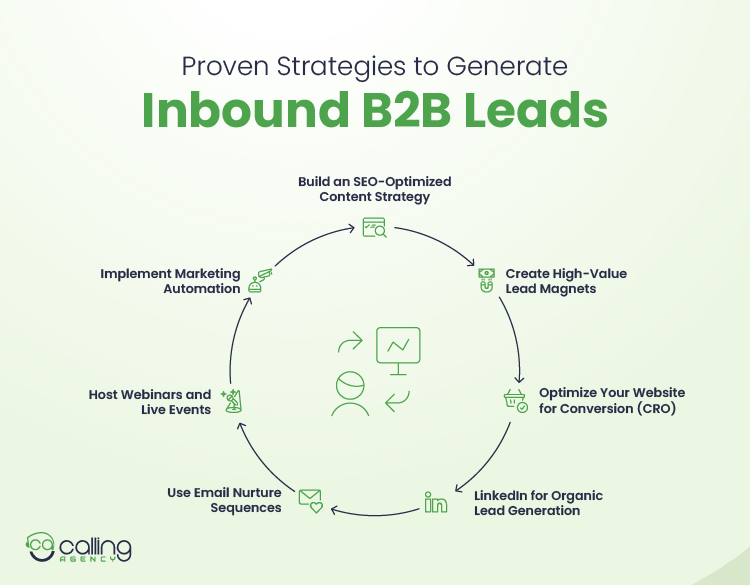
So that your brand stands out and your product is remembered as being worth it, it’s necessary to place your brand in the right online places.
Build an SEO-Optimized Content Strategy
An SEO-focused content marketing strategy involves your audience and keywords. It assesses your current content and produces new quality content tailored to search intent and on-page SEO elements. You can accomplish this by providing an amazing user experience and using internal and external link building. Steady performance tracking enables you to identify and adjust the underperforming areas.
Create High-Value Lead Magnets
- Identify your target audience and their pain points
- Define your lead magnet’s value proposition
- Choose the right format for your lead magnet
- Write and design your lead magnet
- Build a landing page to deliver your lead magnet
- Set up your delivery email
- Promote your lead magnet across channels
- Build a conversion funnel
- Optimize and update your lead magnet
Optimize Your Website for Conversion (CRO)
To improve a website’s conversions, initially enhance the user experience. This includes optimizing site speed, navigation ease, and responsiveness for mobile devices. Consumers prefer easy and light checks, alongside guest checkout options. Value propositions and CTAs must explain the benefits of proceeding without delay. Trust can be established with clear product images with social verification and promotional offers that address a specific group.
LinkedIn for Organic Lead Generation
With organic lead generation on LinkedIn, you don’t have to rely on sponsored ads to generate leads. You gather leads by offering value consistently through optimizing your profile, publishing interesting content, and fostering real connections. LinkedIn lead generation focuses on group participation, trying diverse content styles, implementing lead magnets, and deliberate engagement with other users’ content to enhance visibility and develop trust.
- Optimize your profile
- Build a genuine connection
- Post engaging content
- Engage with others
- Participate in groups
- Experiment with formats
- Use lead magnets
- Link to social media
Use Email Nurture Sequences
Email nurture sequences function as automated targeted email campaigns that send subscribers a series of messages to establish relationships and deliver value while steering them toward specific goals like buying products. The automated email sequences known as drip or lifecycle campaigns start based on subscriber actions to deliver educational content that builds trust and maintains brand visibility.
How to Use Email Nurture Sequence
- Set clear goals
- Identify triggers
- Segment your audience
- Create a series of emails
- Provide value and build trust
- Use calls-to-action (CTA)
- Personalize the content
- Automate the process
- Test and refine
Host Webinars and Live Events
Webinar and live event hosting requires sharing important content while using Q&A sessions and polls to interact with viewers in real-time and prior promotion to build email contacts and attract new leads. A successful event requires choosing appropriate content and platforms and effective promotion and post-event contact with participants.
Implement Marketing Automation
The first step to implement marketing automation requires organizations to establish specific goals which include lead generation and customer retention improvement. The process begins with selecting proper tools followed by audience segmentation and automated workflow development for email sequences and lead nurturing activities. The system requires integration with your CRM software and performance tracking and continuous optimization of your marketing strategy.
- Define your goals and audience- Set objectives like improving lead generation to find automation opportunities that boost engagement and use customer data for audience segmentation to create targeted campaigns.
- Choose the right tools- Choose a marketing automation tool that aligns with your goals, fits your budget, and integrates with your systems.
- Create and implement workflows- Boost efficiency by automating repetitive tasks, such as follow-up emails, and integrating your marketing platform with your CRM for synchronized data. Invest in team training to fully leverage new tools.
- Monitor and optimize- Monitoring key metrics is essential for understanding effectiveness. Tracking these indicators provides insights for optimizing campaigns and improving results.
Example B2B Inbound Lead Funnel
A B2B inbound lead funnel example guides customers through their buying process from awareness to purchase by using stages which include Awareness, Interest, Consideration and Decision.
Example: A software-as-a-service (SaaS) company
Here’s a step-by-step sample of how a B2B SaaS company could leverage an inbound funnel to attract leads for its project management software product.
Awareness
A B2B PM persona at a mid-sized tech company who is overloaded with coordinating tasks with spreadsheets. They go to Google and type in “how to track project deadlines efficiently” or “tips on managing a remote team.”
Inbound action: The project manager discovers an SEO-optimized blog post by the SaaS company titled “The Ultimate Guide to Remote Project Management.”
Outcome: The project manager appreciates the article and signs up for the company’s newsletter to find more tips.
Consideration
After reading this blog, the PM realizes that they don’t have the right software and Googles “best project management tools” or “project management software for mid-size companies.”
Inbound action: An automated email nurture from the SaaS company is activated. It provides a free download: “ROI of Integrated Project Management Solutions.”
Result: The project manager downloads the whitepaper and becomes a marketing qualified lead (MQL), giving specifics to the sales team.
Decision
The project manager is now sold on the software’s value and she is making a business case for her organization’s upper management. She goes back to the company’s website.
Inbound response: The project manager opts-in on a case study detailing how another tech company saved 15 hours per week by using the SaaS product. She also schedules a free, personalized demo.
Result: The sales team gets high-intent leads (Sales Qualified Lead) and is able to book a demo call.
Post-Purchase
It is the company that the project manager works for that buys the software. Using its customer success and marketing teams, the SaaS company is able to facilitate a smooth transition that will lead to a long-term relationship.
Inbound motion: The company offers automated onboarding, a dedicated account manager and customer support portal access. Later, they emailed a survey asking about the experience and success using the software.
Outcome: The project manager becomes a raving fan (public testimonial and contributor to Open Estimates).
Summary
Lead generation and nurturing are the two sides of a coin: the first involves acquiring new leads, and the second focuses on converting them into loyal customers. Lead nurturing is a matter of analyzing your potential customers’ needs and giving them individualized and quick experiences that will lead them to the purchase decision. When done correctly, nurturing will earn trust, increase engagement, and finally lift conversion rates.
Firstly, segment your audience according to their actions and engagement information. In the awareness stage, good content can create interest. Waiting for leads in the consideration stage and offering detailed webinars or case studies can meet their requirements. And at the time when buyers are deciding, individualized demonstrations and free trials can be the powerful final encouragement.
Engagement is the link between nurturing and conversion. Real-time Q&A sessions or polls in addition to webinars make the audience to keep participating actively. Besides, frequent communication within a day helps to keep the momentum going.
Making the conversion process easier with direct calls to action (CTAs), pre-filled forms, and customer reviews can also diminish resistance and build confidence. Focusing on personalization, communication, and seamless conversion will allow you to come up with a lead nurturing plan that will turn your prospects into lifelong supporters.

